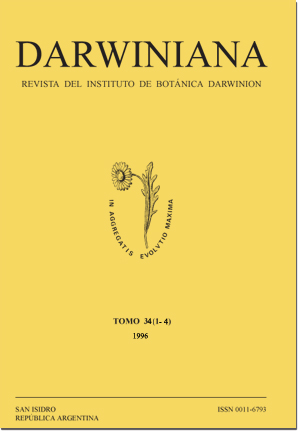Floral trichomes and nectaries in four species of Tecomeae (Bignoniaceae
DOI:
https://doi.org/10.14522/darwiniana.2014.341-4.373Abstract
The structure and anatomy of floral trichomes and nectaries of 4 species of Tecomeae (Bignoniaceae) are studied. All taxa exhibit pluricellular glandular trichomes of different forms anddistributionin calyx, corolla and ovary wall and bear a conspicuous floral nectary except for Catalpa bignonioides Walter. In this species the floral nectary is reduced and appears to be a vestigial organ without a secretory function. The nectary of Argylia radiata (L.) D. Don, Podranea ricasoliana
(Tanfani)Sprague and Pandorea jasminoides (Lindl.) K. Schum. comprises epidermis and secretory parenchyma without intercellular spaces. Secretory tissue is supplied by phloem. Raised nectarial stomata were found only in P. ricasoliana, whereas they are at the same level of the epidermis In the
remainder species. Extrafloral nectaries were found in flowers of P. jasminoides and P. ricasoliana in the outer surface of the calyx. Those of P. jasminoides are cupular and vascularized while those of P.ricasoliana are patelliform and nonvascularized.
Downloads
Published
31-12-2011
How to Cite
Rivera, G. (2011). Floral trichomes and nectaries in four species of Tecomeae (Bignoniaceae. Darwiniana, Nueva Serie, 34(1-4), 19–26. https://doi.org/10.14522/darwiniana.2014.341-4.373
Issue
Section
Anatomy and Morphology
License

Starting on 2012, Darwiniana Nueva Serie uses Licencia Creative Commons Atribución-NoComercial 2.5 Argentina .






